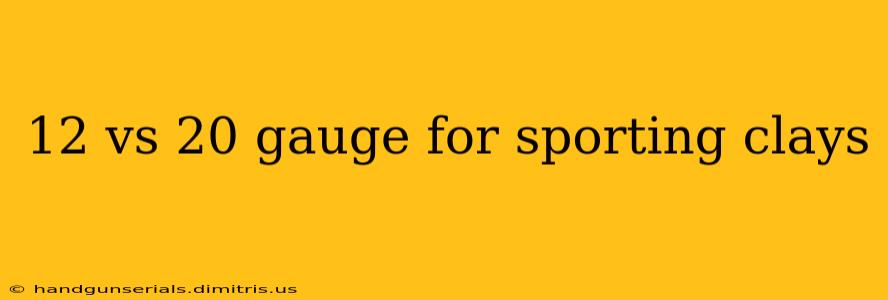Choosing the right gauge shotgun for sporting clays can significantly impact your enjoyment and performance. The debate often centers around the 12 gauge and the 20 gauge, each with its own set of advantages and disadvantages. This detailed comparison will help you determine which gauge best suits your needs and shooting style.
Key Differences: Gauge, Recoil, and Shot Patterns
The fundamental difference lies in the gauge, which refers to the diameter of the barrel. A 12 gauge has a larger bore than a 20 gauge, meaning it fires a larger shot shell. This translates directly to several key distinctions:
Recoil:
-
12 Gauge: Generally produces more recoil. This can be tiring for extended shooting sessions, especially for beginners or those with less upper body strength. However, advancements in recoil-reducing technology are making 12-gauge shooting more manageable.
-
20 Gauge: Offers noticeably less recoil, making it more comfortable for longer periods and ideal for new shooters. The reduced recoil also translates to faster target acquisition and follow-through.
Shot Patterns:
-
12 Gauge: Typically throws a wider shot pattern, providing a larger margin for error. This can be beneficial for less experienced shooters or those targeting more challenging clays. The wider pattern also compensates for less precise aiming.
-
20 Gauge: Produces a tighter shot pattern, demanding more precise aiming. This can be advantageous for experienced shooters aiming for higher scores. While a tighter pattern requires more accuracy, a well-placed shot is often more effective.
Shell Availability and Cost:
-
12 Gauge: Boasts far wider availability of ammunition, with a broader range of shot sizes and loads available at most sporting goods stores.
-
20 Gauge: While readily available, the selection might be slightly more limited than 12 gauge, particularly regarding specialized loads. The cost per round can sometimes be slightly higher, although this can vary depending on the brand and type of ammunition.
Which Gauge is Best for You?
The "best" gauge depends entirely on individual preferences and shooting experience:
12 Gauge: Ideal for…
- Experienced Shooters: Those comfortable managing recoil and prioritizing a wider shot pattern for potentially forgiving shots.
- Power and Versatility: The 12 gauge offers more stopping power and a greater range of ammunition options.
20 Gauge: Ideal for…
- Beginners: Reduced recoil makes it a friendlier introduction to shotgun sports.
- Improved Accuracy: The tighter pattern rewards precise aiming and encourages better shooting technique.
- Enhanced Comfort: Less fatigue during longer sessions allows for more focused practice.
- Smaller Stature Shooters: The lighter weight of a 20-gauge shotgun is often more manageable for individuals with less upper body strength.
Beyond the Gauge: Other Considerations
While gauge is a critical factor, other aspects influence your sporting clays experience:
- Shotgun Fit: Proper gun fit is paramount, regardless of gauge. An ill-fitting gun, regardless of gauge, can negatively impact your accuracy and comfort.
- Ammunition Choice: Experiment with different loads and shot sizes to find what works best for you and your gun.
- Shooting Style: Your personal shooting style plays a significant role in gauge selection. Consider your accuracy, comfort level with recoil, and target acquisition speed.
Conclusion: Make an Informed Choice
Ultimately, the choice between a 12 gauge and a 20 gauge for sporting clays is a personal one. Consider your experience level, physical capabilities, and shooting style to determine which gauge best aligns with your needs and aspirations. Renting both gauges at a local shooting range before purchasing can be invaluable in making an informed decision. Don't hesitate to seek advice from experienced shooters or instructors to help guide your choice.

